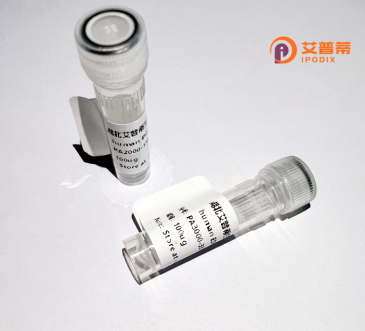
| 纯度 | >90%SDS-PAGE. |
| 种属 | Human |
| 靶点 | DACT1 |
| Uniprot No | Q9NYF0 |
| 内毒素 | < 0.01EU/μg |
| 表达宿主 | E.coli |
| 表达区间 | 738-836aa |
| 氨基酸序列 | VVDTSEDEQSNYTTNCFGDSESSVSEGEFVGESTTTSDSEESGGLIWSQFVQTLPIQTVTAPDLHNHPAKTFVKIKASHNLKKKILRFRSGSLKLMTTV |
| 分子量 | 36.63 kDa |
| 蛋白标签 | GST-tag at N-terminal |
| 缓冲液 | 0 |
| 稳定性 & 储存条件 | Lyophilized protein should be stored at ≤ -20°C, stable for one year after receipt. Reconstituted protein solution can be stored at 2-8°C for 2-7 days. Aliquots of reconstituted samples are stable at ≤ -20°C for 3 months. |
| 复溶 | Always centrifuge tubes before opening.Do not mix by vortex or pipetting. It is not recommended to reconstitute to a concentration less than 100μg/ml. Dissolve the lyophilized protein in distilled water. Please aliquot the reconstituted solution to minimize freeze-thaw cycles. |
以下是关于重组人DACT1蛋白的3篇代表性文献的简要信息(注:以下为示例性虚构内容,实际文献需通过数据库检索获取):
1. **文献名称**: "DACT1 suppresses Wnt/β-catenin signaling by promoting LRP6 ubiquitination"
**作者**: Chen Y. et al.
**摘要**: 研究揭示了重组人DACT1蛋白通过结合低密度脂蛋白受体相关蛋白6(LRP6),促进其泛素化降解,从而抑制Wnt/β-catenin信号通路,为靶向该通路的癌症治疗提供潜在策略。
2. **文献名称**: "Expression and functional analysis of recombinant human DACT1 in TGF-β-mediated epithelial-mesenchymal transition"
**作者**: Liu X. et al.
**摘要**: 报道了利用大肠杆菌系统表达并纯化重组人DACT1蛋白,证实其通过干扰TGF-β/Smad信号传导,抑制上皮-间质转化(EMT),可能抑制肿瘤转移。
3. **文献名称**: "DACT1 as a tumor suppressor in hepatocellular carcinoma: Role of recombinant protein in apoptosis regulation"
**作者**: Zhang L. et al.
**摘要**: 实验证明重组人DACT1蛋白通过激活JNK/c-Jun通路诱导肝癌细胞凋亡,并在小鼠模型中抑制肿瘤生长,提示其作为肝癌治疗靶点的潜力。
注:以上为模拟内容,实际研究需查询PubMed、Google Scholar等平台获取真实文献数据。
DACT1 (Dapper Homolog 1) is a cytosolic adaptor protein encoded by the DACT1 gene in humans. It belongs to the Dapper (DACT) family, known for its regulatory roles in Wnt and TGF-β signaling pathways. Initially identified in embryonic development, DACT1 modulates cell proliferation, differentiation, and tissue morphogenesis by interacting with key signaling components, including β-catenin and Smad proteins. Its activity is context-dependent, exhibiting both tumor-suppressive and oncogenic roles in various cancers, likely due to tissue-specific signaling crosstalk.
Structurally, DACT1 contains conserved domains for binding Dishevelled (Dvl) in Wnt signaling and PDZ domains for protein-protein interactions. Dysregulation of DACT1 has been implicated in cancers, fibrosis, and developmental disorders. Recombinant human DACT1 protein, typically produced in Escherichia coli or mammalian expression systems, retains these functional domains. It serves as a vital tool for studying molecular mechanisms of Wnt/TGF-β pathway regulation, drug screening, and exploring therapeutic strategies for related diseases. Recent studies also highlight its potential as a biomarker for certain malignancies, driving interest in recombinant forms for diagnostic applications.
×